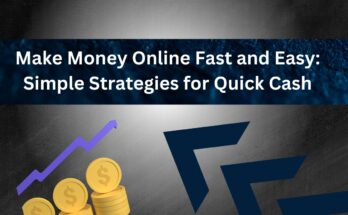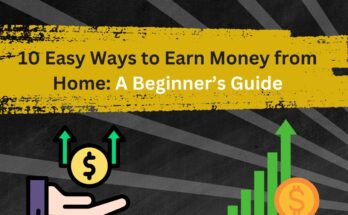Starting a blog is easier than ever, and with the right strategy, it can also become a lucrative side hustle or even a full-time income. Whether you’re a foodie, tech enthusiast, or fashion guru, the blogging world offers endless opportunities for creativity and earning potential. This step-by-step guide will walk you through the entire process of how to start a blog and make money no technical skills are required!
1. Choose a Profitable Niche
The first step to starting a blog and making money is picking the right niche. Your niche should strike a balance between your passion and what’s profitable. Consider areas that you love and that have a sizable audience. Some popular blogging niches that have proven to be profitable include:
- Personal Finance: Helping others manage their money and investments.
- Health & Fitness: Sharing workout routines, diet plans, or mental health tips.
- Food Blogging: Recipes, restaurant reviews, and culinary experiences.
- Travel: Destinations, travel tips, and adventure stories.
- Tech & Gadgets: Reviews, tutorials, and updates on the latest tech trends.
Once you’ve chosen a niche, ensure it’s not oversaturated. Use keyword research tools like Google Keyword Planner to see how many people are searching for topics within your chosen niche. The more interest there is, the more opportunities you’ll have to monetize.
2. Pick a Domain Name and Web Hosting
Now that you have your niche, it’s time to choose a domain name. Your domain is the web address where readers will find your blog (e.g., www.yourblogname.com). Keep it simple, easy to spell, and related to your niche. If your blog is about fitness, for example, consider something like “FitWithMe.com” or “HealthNerd.com.”
Once your domain name is ready, you’ll need a reliable web hosting provider. Popular options like Bluehost, SiteGround, and HostGator offer beginner-friendly setups with WordPress integration. WordPress is one of the best blogging platforms for beginners, thanks to its ease of use and customization options.
Quick Tips:
- Look for hosting providers offering free domain names.
- Ensure they have great customer support, especially if you’re new to blogging.
- Check for features like SSL certificates (a must for secure websites).
3. Install WordPress and Pick a Theme
With your domain and hosting sorted, it’s time to get your blog live. WordPress is the most recommended platform for starting a blog because of its flexibility and most web hosts offer one-click WordPress installation. Once WordPress is installed, you can start customizing your site.
Choosing a theme is crucial for the overall look and feel of your blog. If you want a sleek and professional design, you can either choose from thousands of free themes or go for premium themes from places like ThemeForest or Elegant Themes. Make sure your theme is mobile-friendly and SEO-optimized for the best results.
Pro Tip:
- Choose a theme that reflects your niche and personal style.
- Avoid overly complicated designs that can slow down your blog.
- Opt for themes with built-in SEO features and customizable options.
4. Create Essential Pages
Before you dive into blogging, make sure you set up some essential pages to give your blog structure and credibility. These are the must-have pages for any blog:
- About Page: This tells readers who you are, what your blog is about, and why they should follow you. Keep it personal and engaging.
- Contact Page: Provide a way for readers or potential business partners to reach you. You can include a contact form or list your email.
- Privacy Policy: This is crucial for legal reasons, especially if you plan on monetizing your blog. It informs readers about how you collect and use their data.
- Disclaimer: If you’re recommending products or using affiliate links, you must disclose this on your blog.
5. Plan Your Content Strategy
Content is the backbone of your blog. Before you start publishing, plan a content strategy that will keep readers coming back for more. Focus on high-quality, informative posts that provide real value to your readers. Here’s how to start:
- Do Keyword Research: Use tools like Google Keyword Planner, Ubersuggest, or SEMrush to find topics people are searching for within your niche. For example, if you’re in the food niche, you could write about “10 Easy Recipes for Beginners” or “Healthy Snacks on a Budget.”
- Create Pillar Content: This is in-depth content that covers all aspects of a specific topic. Pillar posts attract traffic and establish your blog as an authority.
- Keep a Content Calendar: Consistency is key when trying to start a blog and make money. Plan your posts ahead of time using a calendar so you’re always prepared with fresh content.
Blog Post Ideas to Get You Started:
- “How-To” Guides
- Product Reviews
- Listicles (Top 10, Best of, etc.)
- Case Studies
- Personal Stories or Experiences
6. Drive Traffic to Your Blog
Great content is only half the battle. To start a blog and make money, you need traffic. Without readers, there’s no one to click your affiliate links or purchase your products. Here are some proven ways to boost your blog traffic:
a) SEO (Search Engine Optimization):
SEO is crucial to getting your blog ranked on search engines like Google. Optimizing your posts for relevant keywords, using meta descriptions, and building backlinks can improve your visibility. Always include your primary keyword in the title, first paragraph, and throughout the content. But don’t overstuff your post with keywords—that can hurt your ranking.
b) Social Media Promotion:
Share your blog posts across different social platforms like Instagram, Twitter, Pinterest, and Facebook. Pinterest, in particular, is an excellent platform for bloggers in niches like food, home decor, and DIY. Tailor your promotion strategies according to where your target audience hangs out.
c) Email Marketing:
One of the most effective ways to build a loyal audience is through email marketing. Create a freebie (like an ebook or checklist) to encourage visitors to sign up for your email list. Regularly send newsletters packed with value to keep them engaged.
d) Guest Posting:
Write guest posts for other blogs in your niche. This helps you reach a new audience while also building backlinks that improve your site’s SEO. Aim for reputable blogs that already have a good readership.
7. Monetize Your Blog
Now comes the exciting part—how to start a blog and make money! There are several ways to monetize your blog depending on your niche and audience size.
a) Affiliate Marketing:
Affiliate marketing involves promoting products or services and earning a commission for each sale made through your affiliate link. Choose affiliate programs related to your niche, such as Amazon Associates or ShareASale. Focus on products you genuinely believe in to build trust with your audience.
b) Sponsored Posts:
Once your blog gains traction, brands may pay you to write about their products or services. Sponsored posts are an excellent way to make money from your blog without needing to rely on advertising. Make sure to disclose any paid partnerships to your audience.
c) Ad Networks:
Displaying ads on your blog is another common way to earn money. Once you have a consistent stream of traffic, you can apply to ad networks like Google AdSense or premium networks like Mediavine. However, be cautious about cluttering your blog with too many ads, as this can deter readers.
d) Sell Digital Products:
If you have expertise in your niche, consider creating and selling digital products like eBooks, courses, or printables. These products offer a passive income stream once they’re up and running.
By following these steps, you can easily start a blog and make money. With dedication and smart strategies, you’ll be well on your way to building a successful blog that brings in traffic and revenue.



